12 quick recipes to reboot your gut health
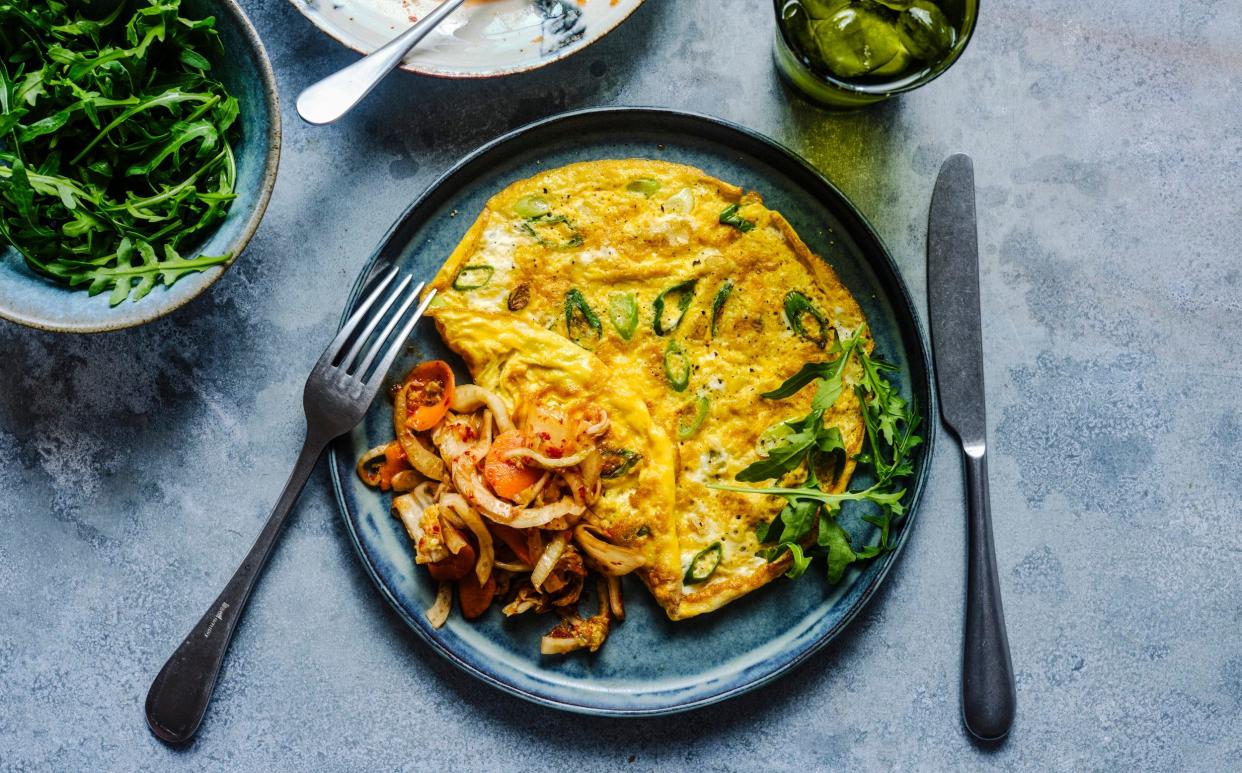
Not a week goes by without another study extolling the virtues of a healthy microbiome. From the efficient digestion of food, to supporting the immune system and even improving our mood, it seems there’s little our gut bacteria can’t do. Indeed recent research from the renowned Zoe nutrition project has identified 15 “good” gut bugs that are linked with lower weight and less visceral, or belly fat, so having a healthy gut can also help trim our waistline.
So what constitutes a healthy gut? There’s no official definition but there are certain attributes of the microbiome that are associated with good health, including the diversity of the bacterial species present, as well as the stability and resilience of the microbiome. This means one that is resistant to disruption and recovers quickly after a disturbance – for example, following an illness.
There is a plethora of “probiotic” supplements available now that claim to improve gut health, but registered dietitian Laura Clark, the creator of the Pause to Nourish programme, advises a food-first approach.
She says: “Factors beyond our control can influence the effectiveness of probiotic supplements, for example gender and our overall health. We may be better off investing our time and effort into eating foods that enable our good bacteria to thrive and help stave off hunger pangs.”
So here is how to improve your gut health in just four weeks by making some simple dietary tweaks.
Meal plan
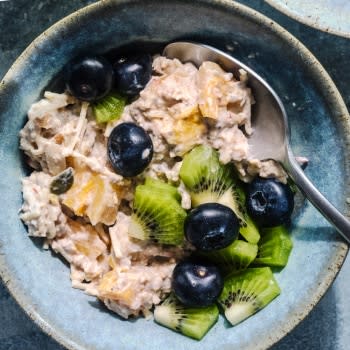
10-plant-foods overnight oats
Rainbow vegetable crustless quiche
Sayur lodeh (Indonesian vegetable and tempeh curry)
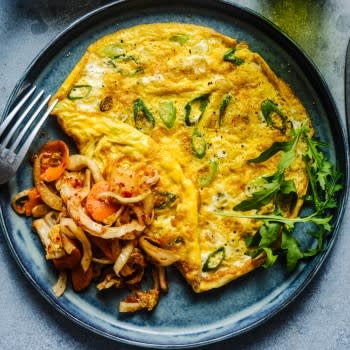
Easy kimchi
Kimchi and spring onion omelette
Sticky miso maple aubergines
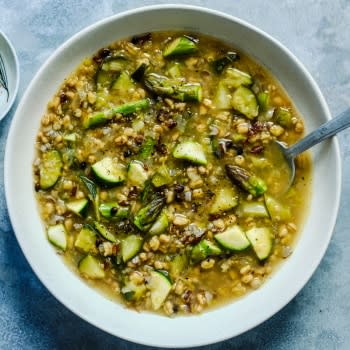
Good guts prebiotic soup
Borlotti bean and bacon soup
Wild salmon poke bowl
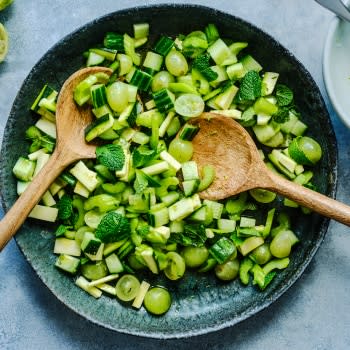
Gut-friendly smoothie
Everyday dal
Re-hydrating salad
Week 1: 30 plant foods a week
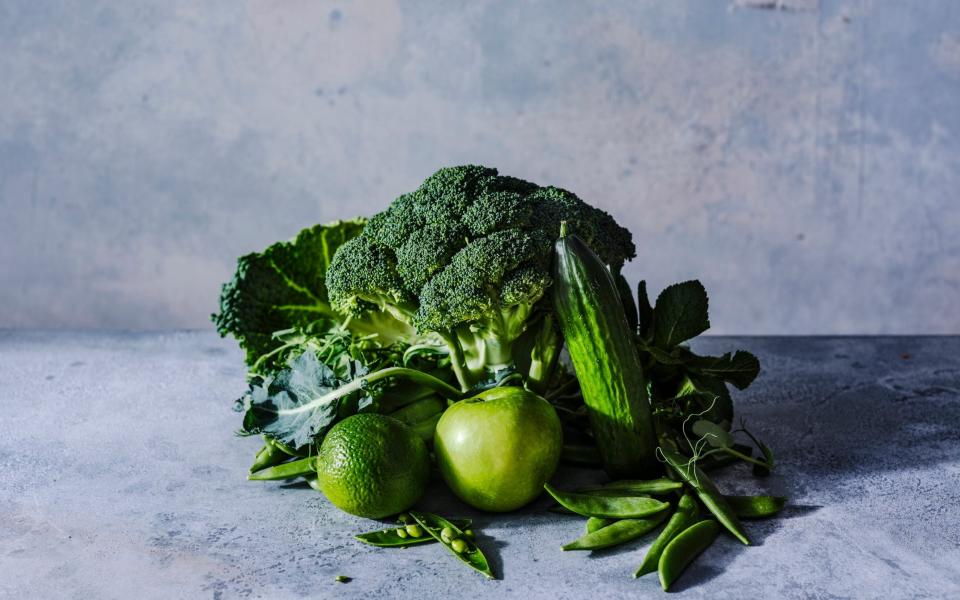
Research from the American Gut Project found the single best thing you can do for your gut health is to eat 30 different plant foods a week. Leading UK gut experts such as Prof Tim Spector and Dr Megan Rossi, support this advice. It might seem a tall order but the term “plant foods” includes not just fruit and vegetables but grains, legumes, nuts, seeds, herbs and spices.
This week, give your gut a further boost by reducing the added or “free” sugar in your diet. Studies show that a high sugar intake can negatively alter our gut bacteria leading to an increased risk of chronic inflammation, which in turn makes us more susceptible to weight gain.
Most of the added sugar we consume comes from ultra-processed foods (UPFs) such as biscuits, breakfast cereals, soft drinks, ready meals, sauces and dressings.
Check the ingredients in the things you buy regularly. If they contain more than 5g of sugar per 100g – the NHS defines “low sugar” as less than 5g/100g – or any unrecognisable ingredients, look for a lower-sugar, non-UPF alternative, or make your own homemade version.
Week 1 recipes
10-plant-foods overnight oats
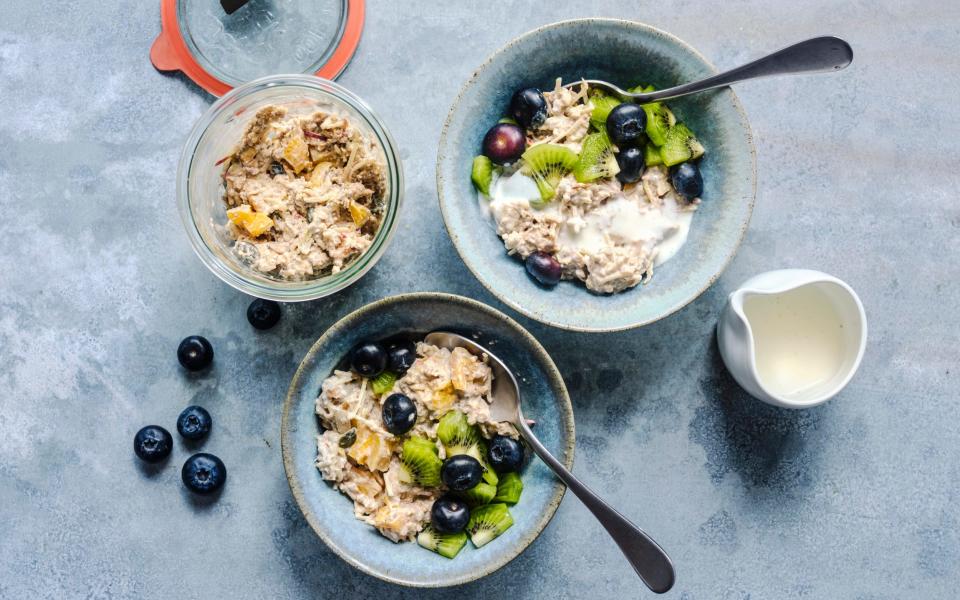
Prep time: 10 minutes
Serves: 3
Calories per serving: 361
Overnight oats is the easiest way to get a headstart on your 30-plant-foods a week challenge. This particular recipe contains 10 so you’re already 33 per cent of the way there, and it’s a veritable microbiome banquet; the yogurt provides probiotics and there are prebiotics and fibre from the apples, seeds and nuts. This recipe will make enough for three breakfasts.
Ingredients:
100g rolled oats
1 tbsp each chia, flax, sunflower and pumpkin seeds
1 tbsp flaked almonds
5 walnut halves, chopped
5 dried apricots, chopped
1 small apple, grated with skin on
1 tsp cinnamon
150ml live yogurt (or kefir), or a little more if needed
200ml semi-skimmedmilk
Method:
Place all the ingredients in an airtight container and mix thoroughly.
Put the lid on and pop in the fridge overnight.
In the morning give it a good mix, place a serving (a third) in a bowl and add a little more kefir to loosen if it needs it.
As an option, top with chopped fruit for even more plant-food goodness.
Rainbow vegetable crustless quiche
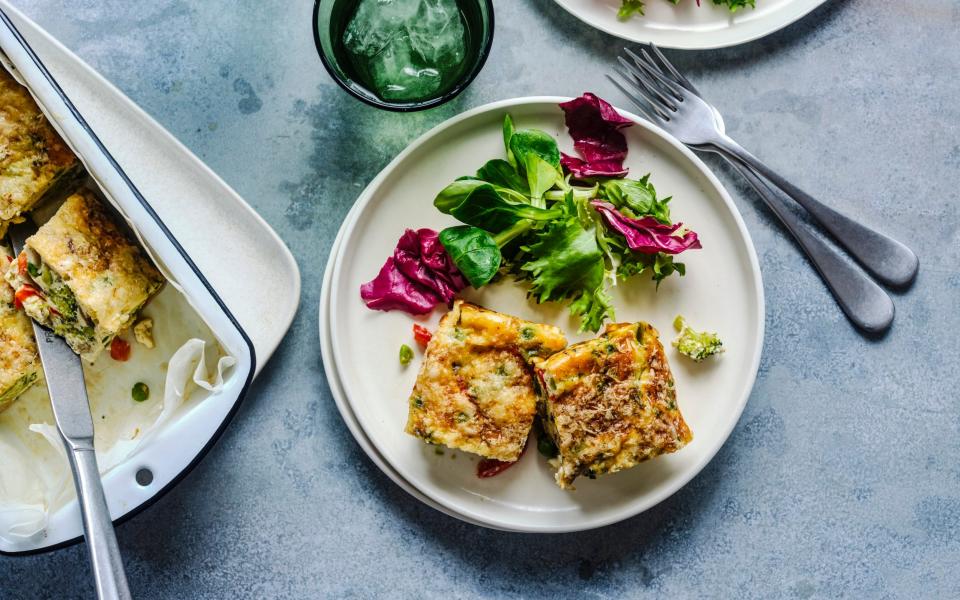
Prep time: 10 minutes
Cooking time: 50 minutes
Serves 4
Calories per serving: 247
If you love quiche but can’t be bothered with the pastry, then this crust-free version is a good alternative. It provides lots of fibre from the five plant foods it contains, prebiotics from the onions and probiotics from the Parmesan, which is added after cooking to preserve the good bacteria which can die off when exposed to high cooking temperatures.
Ingredients:
4 large eggs
250ml milk
75g frozen peas
1 tbsp light olive oil
1 small red onion, finely sliced
½ red pepper, deseeded and finely sliced
75g broccoli, cut into tiny florets
100g cannellini beans, drained and rinsed
50g Parmesan cheese, finely grated
Method:
Preheat the oven to 200C/180C fan/gas mark 6 and line a deep rectangular tin (approx 20cm x 15cm) with baking parchment (make sure it comes up higher than the top of the tin, so you can lift it out easily).
Whisk together the eggs and milk in a jug and season really well with salt and pepper.
Defrost the peas by covering them with boiling water, then drain.
Heat the oil in a large frying pan over a medium heat and add the onion, red pepper and broccoli. Slowly fry until soft (about 5 minutes).
Add the peas and beans and cook gently for a further 5 minutes. Everything should be softened but not browned.
Now place the vegetables in the prepared dish, pour over the egg and milk mixture and bake for 40 minutes until firm and nicely browned.
Remove from the oven and sprinkle over the Parmesan cheese which will melt gently on top. Leave to cool slightly before lifting out of the tin. Cut into quarters and serve.
Sayur lodeh (Indonesian vegetable and tempeh curry)
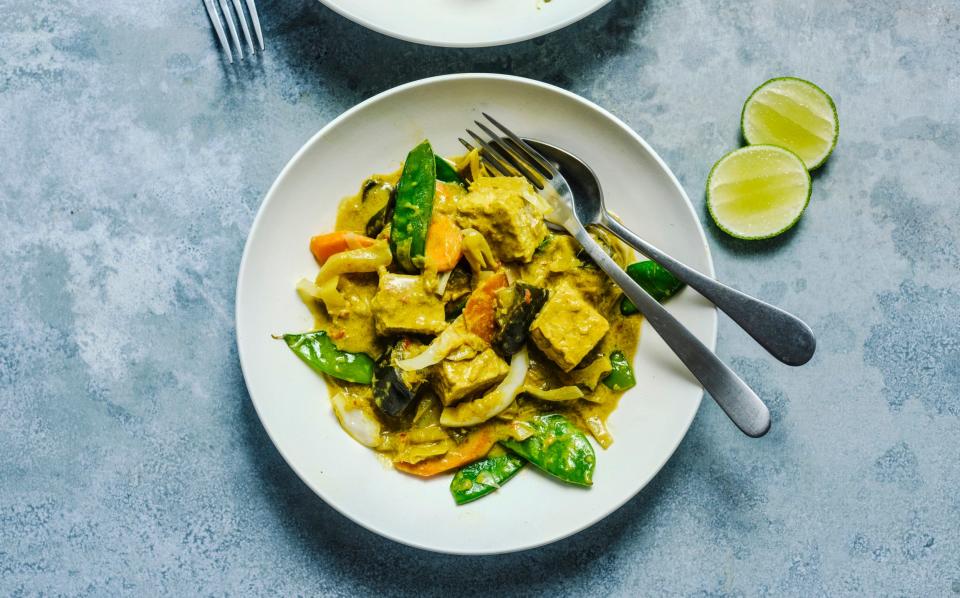
Prep time: 15 minutes
Cooking time: 20 minutes
Serves 4
Calories per serving: 291
Don’t be put off by the long list of ingredients; they all count towards your 30 plant foods a week and this recipe is a great introduction to tempeh, tofu’s firmer, arguably more approachable, cousin. Tempeh is made from fermented soybeans and is packed with probiotics, so it’s added just 10 minutes before the end so that more of the probiotics within are retained.
For the spice paste:
1 stick lemongrass (outer layer taken off), roughly chopped
2 small red chillies, deseeded
1 small red onion, roughly chopped
3 garlic cloves, roughly chopped
2½ piece of fresh ginger, peeled and roughly chopped
1 tsp ground cumin
1 tsp ground coriander
1 tsp ground turmeric
1 tbsp fish sauce
2 tbsp neutral oil
2 tbsp water
For the curry:
1 x 400ml tin light coconut milk
1 carrot, peeled and thinly sliced
½ small white cabbage, sliced
1 pack mangetout
1 small aubergine, cut into chunks
1 block (200g) tempeh, cut into 2cm cubes
1 lime, cut into wedges, to serve
Method:
Place all the spice paste ingredients in a blender and blend for a minute or so until it forms a paste. If too thick to blend properly, add a drop more water.
Place a wok over a medium heat and fry the spice paste for 2-3 minutes, being careful not to burn.
Add the coconut milk and an equal amount of water and mix well until fully combined with the spice paste. Taste and add salt as required.
Add the vegetables and bring up to a gentle simmer; let cook for 10 minutes, then add the tempeh and cook for a further 10 minutes. Serve with a wedge of lime to squeeze over.
Week 2: Probiotics

With the results of week one literally under your belt, you should start to feel the benefits, with more regular bowel movements, increased energy and better mood.
We build on this in week two by adding more probiotic foods to the menu. Probiotic foods contain live bacteria which help increase the diversity of our microbiome. Studies suggest that probiotics may reduce the number of calories you absorb from food and help regulate appetite hormones and aid weight loss.
Introduce probiotic foods such as fermented foods – kimchi, kombucha, kefir and the more familiar sauerkraut – and try to eat some every day. Look for “live” or “raw” products rather than those that are pasteurised, which kills off any live bacteria. Live yogurt and aged cheeses such as mature cheddar, Parmesan, and Edam are also probiotics.
Week 2 recipes
Easy kimchi
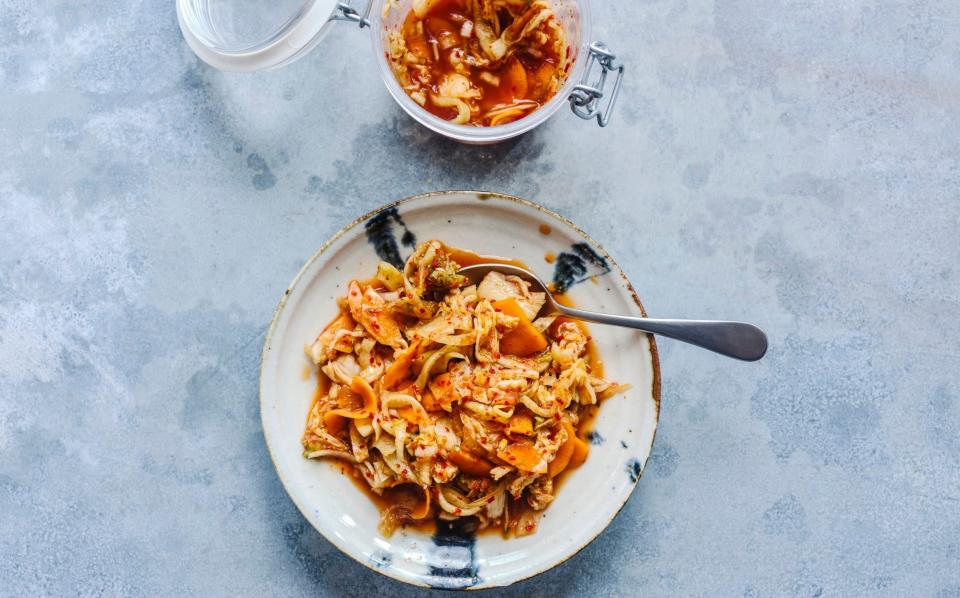
Prep time: 15 minutes, plus 3 hours to ferment
Makes 28 x 50g portions
Calories per serving: 27
If you have yet to try fermenting this is a good place to start. It’s my go-to kimchi recipe and I think it will become yours, too.
Ingredients:
300g carrots, thinly sliced
450g fennel, thinly sliced
400g Chinese leaf cabbage, chopped
75g golden caster sugar (this is required to enable the fermentation process)
1 tbsp salt
For the spice paste:
15g dried red chilli flakes
3 garlic cloves, finely grated
50g ginger, peeled and finely grated
4 tsp fish sauce
3 tsp light soy sauce
5 spring onions, finely sliced
Method:
Sterilise a large, lidded storage jar with boiling water and allow to dry thoroughly before you begin.
Place the prepared carrot, fennel and cabbage (you can slice them in a food processor for speed) in a large bowl. Add the sugar and salt and massage the vegetables with clean hands; do this for at least 5 minutes until liquid starts to be released.
Cover with a tea towel and leave to one side for 2 hours.
Meanwhile combine all the paste ingredients in a small bowl and mix well.
After the 2 hours are up, add the paste to the vegetables and combine thoroughly. Pack the mixture into the storage jar, pressing down firmly. Pour the liquid remaining in the bowl into the jar; it needs to completely cover the vegetables so top up with a little water if needed.
Leave 3cm of space at the top of the jar to allow the escaping fermenting gas some room. Leave open at room temperature for an hour before closing the lid and placing in the fridge.
The kimchi can be eaten the next day, but the flavour will develop over the following weeks and will keep for up to six months in the fridge.
Kimchi and spring onion omelette

Prep time: 2 minutes
Cook time: 5 minutes
Serves 1
Calories per serving: 196
This very simple recipe calls for kimchi which you can buy in the supermarket (choose the raw versions in the chiller cabinet) or use your own. The kimchi is added after cooking the eggs rather than added to the pan, to preserve all the lovely probiotics.
Ingredients:
2 eggs
1 tsp sesame oil
1 spring onion, finely sliced
2 tbsp kimchi
Method:
Whisk the eggs together in a bowl.
Heat the sesame oil gently in a large frying pan.
Add the eggs and swirl to cover the pan base.
Add the spring onion and season with salt and pepper. Cook for 3-4 minutes, then flip over and finish on the other side for a minute or so.
Dollop the kimchi on top and eat immediately.
Sticky miso maple aubergines
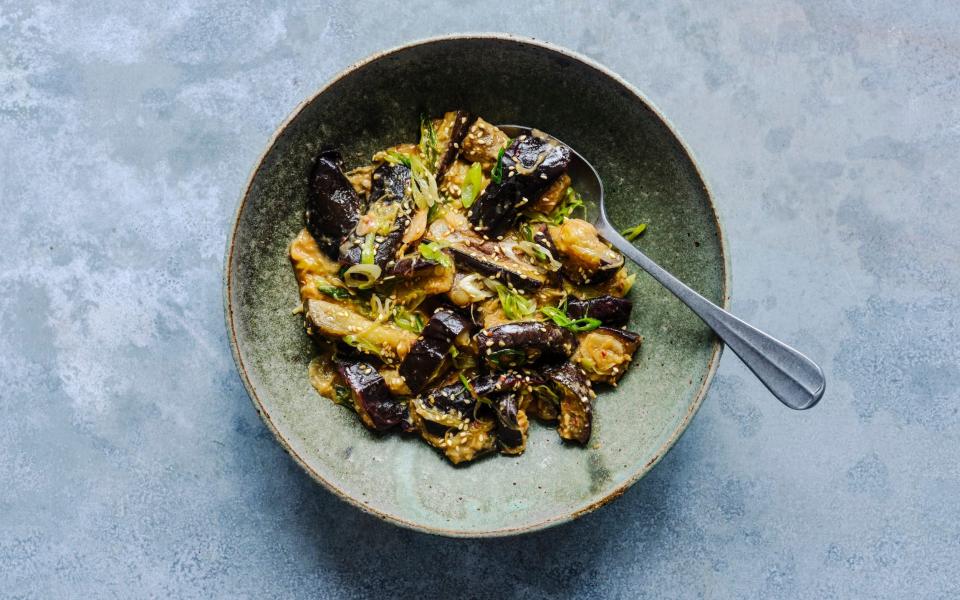
Prep time: 10 minutes
Cook time: 25 minutes
Serves 4
Calories per serving: 93
Miso is a paste made from fermented soybeans best known as the base for the Japanese staple miso soup, but it also works brilliantly as a marinade. For a complete meal, I serve these spicy, sticky aubergines with brown rice and a simple fried egg on top (which brings it to about 250 calories).
Ingredients:
1 large aubergine
1 tsp cornflour
2 tbsp miso paste
1 tbsp maple syrup
Juice of 1 lime
1 tbsp plus 1 tsp neutral oil
2 spring onions, finely sliced
2 garlic cloves, peeled and finely sliced
2-3cm piece of ginger, peeled and finely diced
½ tsp dried red chilli flakes (or to taste)
2 tsp sesame seeds, toasted, to serve
Method:
Prepare the aubergine by cutting it in half lengthways, then cut each half horizontally into three pieces. Slice each third into 2cm-wide batons.
Place the batons in a bowl, sprinkle over the cornflour and toss well.
Combine the miso, maple and lime juice in a bowl with 100ml cold water and mix well with a fork to make a sauce.
Now heat a wok or large saucepan on a medium heat and add 1 tbsp of oil. Add the aubergine batons and sauté for about 15 minutes until softened and the edges slightly browned. Keep an eye on them, stirring occasionally. When the aubergines are tender, remove them from the pan to a plate.
Add the remaining teaspoon of oil to the pan followed by the spring onion, garlic, ginger and chilli flakes and fry for a minute or so.
Return the aubergines to the pan and add the sauce mixture. Continue to cook for several minutes until the sauce has thickened.
Meanwhile, in a small non-stick pan, toast the sesame seeds for a few minutes until golden and sprinkle over the aubergines to serve.
Week 3: Prebiotics
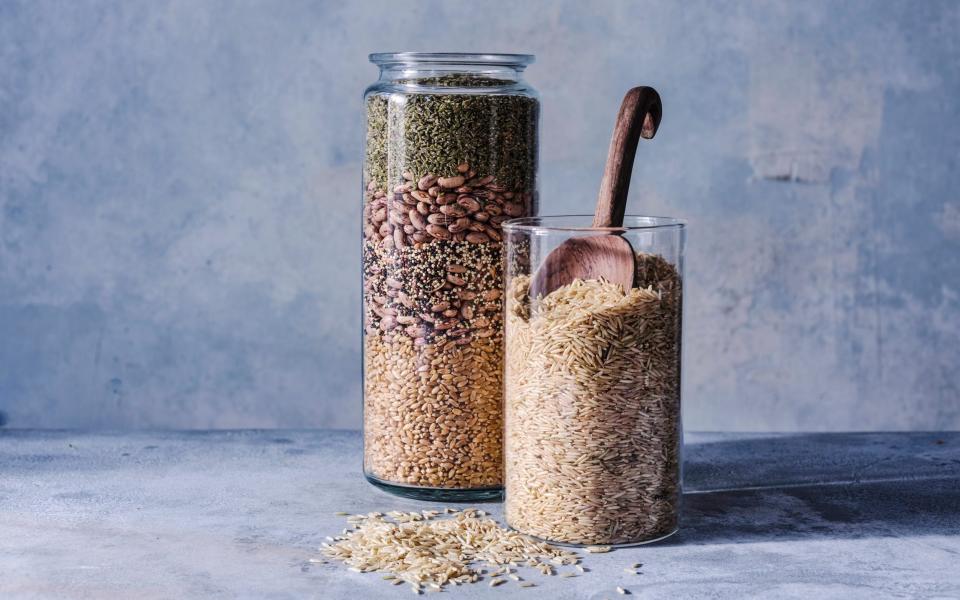
By now your gut should be teeming with health-giving microbes that need feeding. So up your intake of prebiotic foods.
Prebiotic foods contain a particular type of fibre that passes through the gut undigested and feeds certain good bacteria in the large intestine. Good sources of prebiotics are slightly under-ripe bananas, leeks, garlic, onions, asparagus, barley, oats and cooked and cooled rice.
As an added bonus, researchers at the University of Leipzig Medical Centre found that after two weeks on a prebiotic-packed diet, the study participants had a more muted brain response to high-calorie “reward” foods. In other words, the more prebiotic foods you eat, the less likely you’ll be to crave sugary junk.
Week 3 recipes
Good guts prebiotic soup
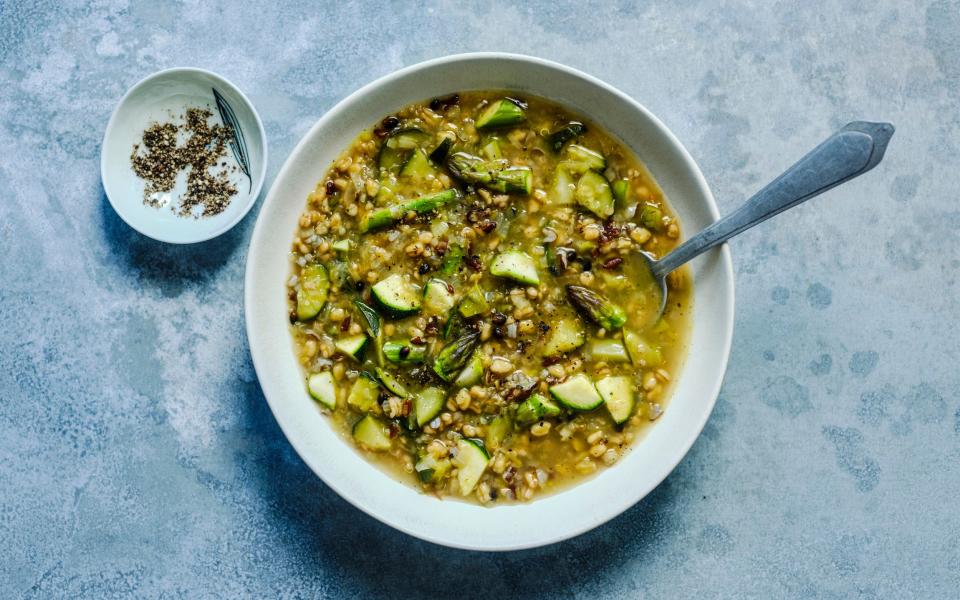
Prep time: 10 minutes
Cooking time: 30 minutes
Serves 4
Calories per serving: 171
Prebiotics are a form of carbohydrate that the good bacteria in your gut love to feast on. This soup contains some of the best prebiotic foods out there, so your microbiota are in for a treat. I like to stir in a spoon of live Greek yogurt or kefir before eating for even more gut goodness.
Ingredients:
1 onion, peeled and quartered
1 leek, trimmed and chopped into 4 pieces
1 tbsp light olive oil
125g asparagus, woody ends removed
1 courgette, ends removed and chopped into four
800ml vegetable stock
1 x 250g pouch of pre-cooked mixed grains
Juice of 1 lemon
Method:
Finely chop the onion and leek, using a food processor.
Place a large saucepan on a medium heat, add the oil, then tip in the onion and leek and sauté gently while you chop the asparagus and courgette in the food processor then add them to the pan.
Stir all the vegetables together and sauté for a further 2-3 minutes.
Now add the stock and the grains, stir well and season generously with salt and pepper.
Bring to the boil and then turn down the heat and simmer for 20 minutes.
Finally, add the lemon juice, stir well and taste. Add more salt and pepper if required before serving.
Borlotti bean and bacon soup
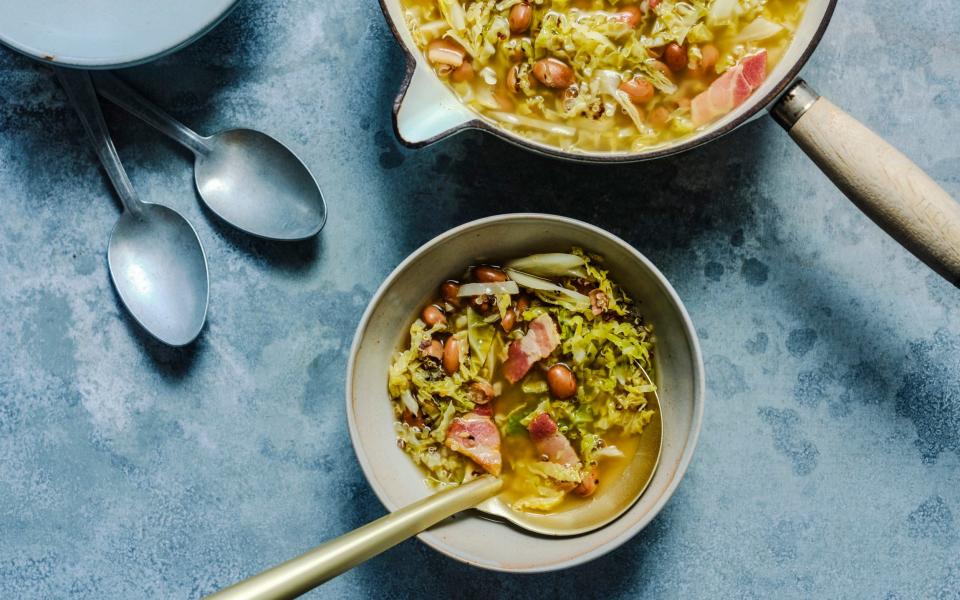
Prep time: 10 minutes
Cook time: 25 minutes
Serves 2
Calories per serving: 396
Cabbage, beans and quinoa provide plenty of prebiotics and fibre which will fill you up and keep your microbiome happy. Bacon is used sparingly simply to flavour the dish, but without overdoing it. The government recommendation is that we eat no more than 70g of processed or red meat per day; this recipe contains about 65g but it serves two.
Ingredients:
3 rashers streaky bacon, sliced
250g savoy cabbage, finely sliced
1 x 400g tin borlotti beans, drained and rinsed
50g quinoa, rinsed thoroughly
750ml vegetable stock
2 tsp apple cider vinegar
Method:
Heat a large saucepan over a medium heat and add the bacon. Fry gently for a few minutes until most of the fat has been released but not browned.
Then add the savoy cabbage and give it all a good stir.
Now add the beans and the quinoa and pour over the stock. Add the apple cider vinegar and season very well with salt and pepper.
Bring to the boil, then turn down and simmer for 20 minutes.
Wild salmon poke bowl
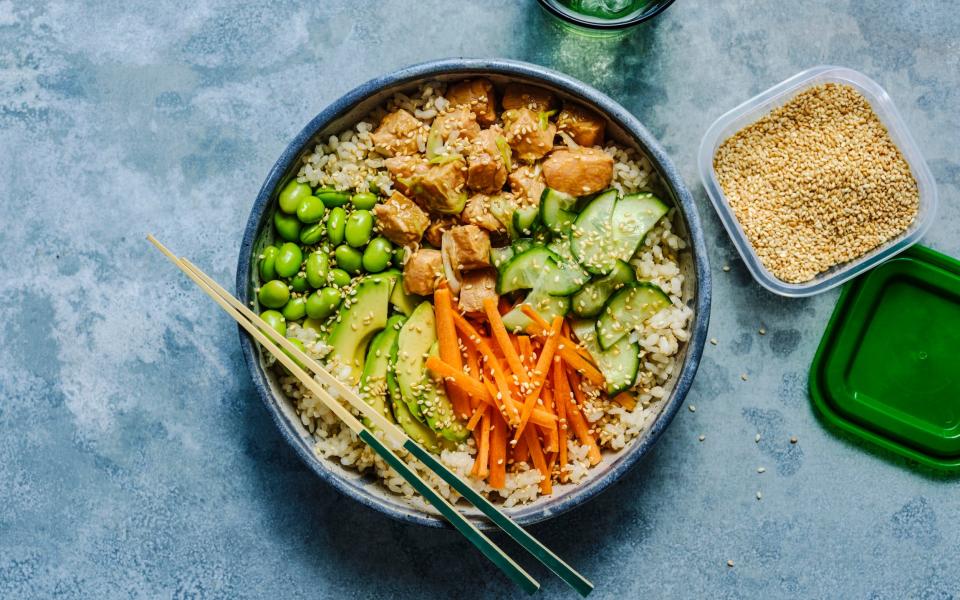
Prep time: 15 minutes
Cook time: 3 minutes
Serves 2
Calories per serving: 501
An Asian-style ceviche. Make sure you have a really good quality piece of fresh, wild salmon, and look for the blue Marine Stewardship Council (MSC) mark for sustainability. This bowl contains seven plant foods as well as prebiotics in the form of resistant starch from the cooked and cooled rice. You can buy frozen, podded edamame beans in the supermarket. Just defrost in boiling water before use.
Ingredients:
1 x 250g pouch pre-cooked wholegrain rice
1 tsp sesame oil
200g fillet wild salmon, skin removed
2 tbsp soy sauce
Juice of ½ lime
1 tsp ginger, peeled and finely grated
2 spring onions, finely sliced
4 tbsp rice vinegar (or other light-coloured vinegar)
2 tsp honey
100g cucumber, sliced in half and then cut into semi-circles
75g edamame beans
1 medium carrot, peeled and cut into thin strips (julienne), or grated
½ an avocado, peeled, stoned and sliced
1 tsp toasted sesame seeds, to serve
Method:
Boil a kettle of water, empty the pouch of rice into a sieve and, holding it over the sink, pour over the boiling water. Now run the cold tap over the rice and drain thoroughly. Place the refreshed rice in a bowl and pour over the sesame oil, add a pinch of salt and mix well.
Using a sharp knife, cut the salmon fillet into neat 1-2cm cubes.
Place the soy sauce, lime juice, ginger and spring onions in a bowl, mix well, add the salmon cubes and mix again to ensure the fish is completely soaked in the dressing. Set aside.
Place the rice vinegar and honey in a bowl and whisk together. Add the cucumber, toss to coat and leave to marinate for a few minutes.
To serve, divide the rice between two bowls. Place half the salmon on top and arrange the cucumber, edamame beans, carrot and avocado around the side. If there’s any of the fish marinade left in the bowl, drizzle it over and finish with the toasted sesame seeds.
Week 4: Fibre
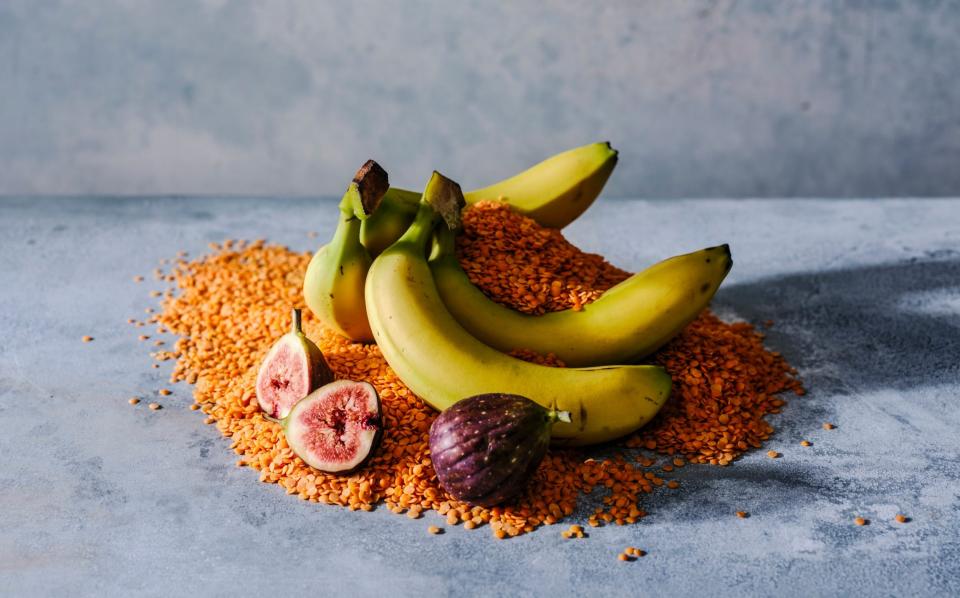
After three weeks of packing in plants, probiotics and prebiotics, it is time to introduce more fibre, which acts as the gut’s housekeeper. Fibre is a type of indigestible carbohydrate that moves down the intestinal tract like a big brush, sweeping out unwanted debris and preventing constipation. It also plays an important part in weight management by slowing down digestion, helping to regulate appetite and stabilising blood sugar levels.
The recommended daily intake of fibre is 30g, but most of us miss this target by a long shot. The UK average intake is 20g, so most of us could do with eating more. Wholegrains, fruit, vegetables, nuts, legumes and potatoes in their skins are the best sources. For example, a slice of wholegrain bread contains 4g fibre, 100g raw carrots has 3g, a pear has 6g, 30g almonds 3g, 100g cooked lentils 8g and a medium-sized potato with the skin on, 5g. Try to include fibre-rich foods at each meal, and snack on fruit, hummus or veggie sticks to up your fibre intake.
Week 4 recipes
Gut-friendly smoothie
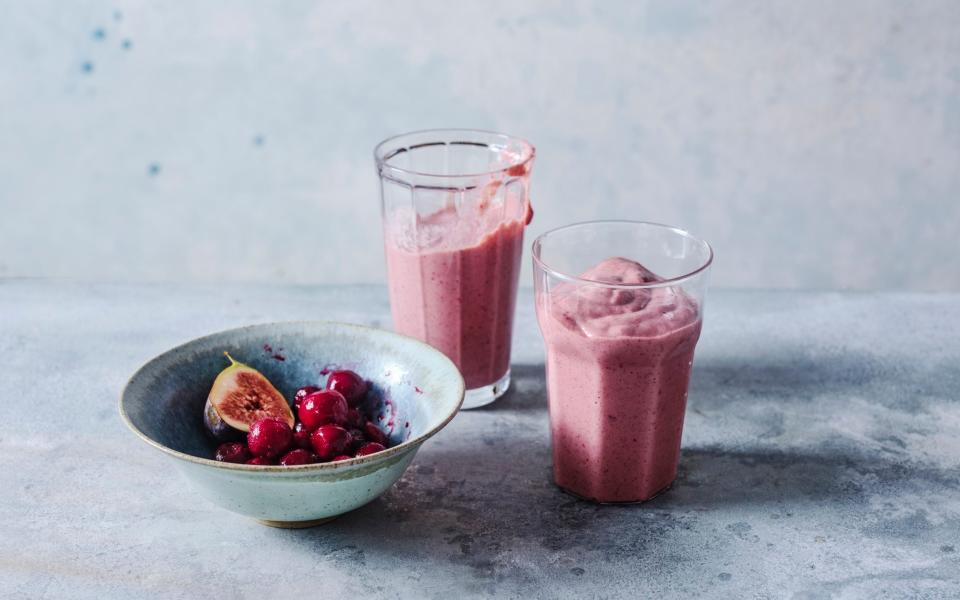
Prep time: 5 minutes
Serves 1
Calories per serving: 280
This smoothie is a delicious combination of gut goodies: figs are fibre-rich, almonds and chia seeds are gut-friendly sources of plant protein and the banana and cherries provide the requisite sweetness. It is also an easy way to get started with kefir, a fermented yogurt teeming with beneficial bacteria but which can taste quite sour on its own.
Ingredients:
5 almonds
2 tsp chia seeds
2 fresh figs, stalks removed and cut into quarters
1 small banana, peeled and broken into pieces
75g frozen cherries
4 tbsp plain kefir
Method:
Put the almonds and chia seeds into a blender and whizz to grind finely.
Then add the remaining ingredients, along with 100ml cold water, and blend on high for 30 seconds until smooth.
Enjoy straight away.
Everyday dal
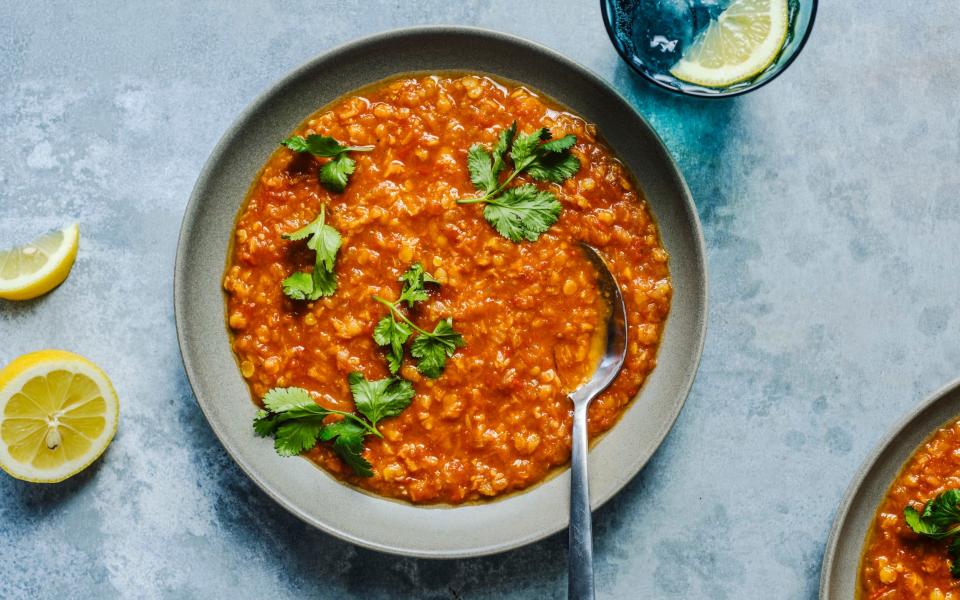
Prep time: 10 minutes
Cook time: 45 minutes
Serves 2
Calories per serving: 317
I’ve played fast and loose with authenticity here in the interests of speed, but the main flavour elements are all there. This is about as simple a weekday meal as you’ll get that still hits home nutritionally and provides a very welcome 10g fibre per serving. For even more fabulous fibre, pair with a toasted wholegrain pita.
Ingredients:
1 tbsp neutral oil
1 onion, finely diced
2 garlic cloves, peeled and crushed
2-3cm fresh ginger, peeled and finely grated
1 tsp garam masala
1 tsp ground cumin
½ tsp cayenne pepper
100g red lentils
1 x 400g tin chopped tomatoes
500ml vegetable stock
A handful of chopped coriander leaves (optional)
Method:
Heat the oil in a large saucepan over a medium heat.
Add the onion and gently sauté for 5 minutes.
Add the garlic, ginger, garam masala, cumin and cayenne pepper and mix well, before adding the lentils, then cook for a few more minutes until everything is well combined.
Add the tomatoes, stock and a good pinch of salt.
Bring to the boil then turn down the heat and loosely cover the pan with a lid. Simmer for 30-40 minutes, stirring occasionally. Add a little more water if it’s getting too thick; it should eventually resemble a thick soup.
If you happen to have some fresh coriander, sprinkle some chopped leaves over the top to garnish.
Re-hydrating salad
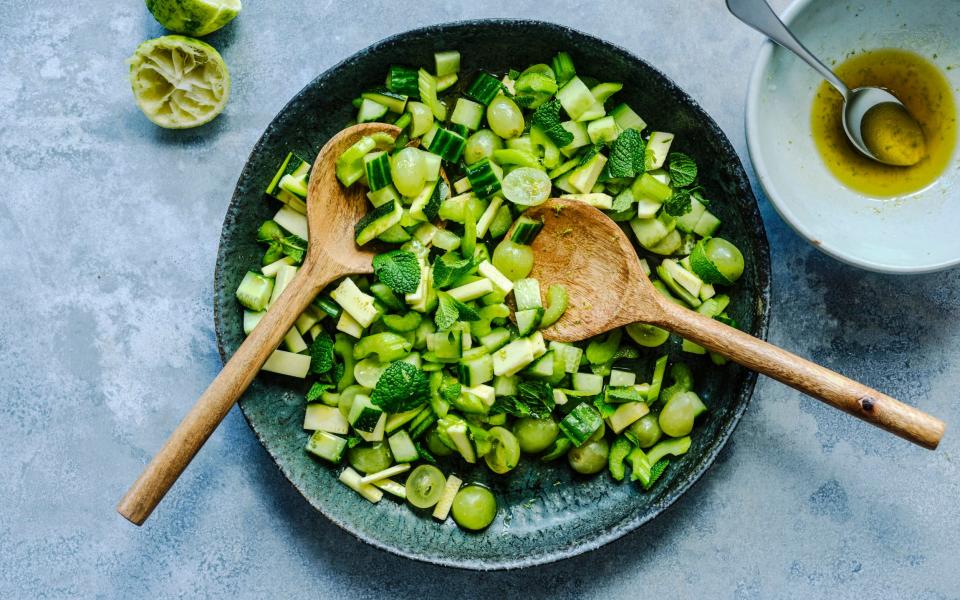
Prep time: 15 minutes
Serves 4
Calories per serving: 79
For the fibre to do its work efficiently in the gut it requires hydration. Of course, you can drink lots of water but what you eat counts too. All the fruit and vegetables used here have a high water content to help you stay hydrated and refreshed. The dressing contains apple cider vinegar which, if you choose a raw one with ‘the mother’, is also a probiotic. Top with your protein of choice for a healthy lunch.
For the salad:
100g green grapes, halved
½ cucumber, cut into 1cm cubes
1 small courgette, cut into 2cm cubes
2 sticks celery, thinly sliced
A handful of fresh mint leaves, sliced
For the dressing
Juice and zest of 1 lime
1 tbsp extra virgin olive oil
1 tsp honey
1 tsp apple cider vinegar
Method:
Place the salad ingredients in a large bowl and put in the fridge to chill for 10 minutes.
Place the dressing ingredients in a small airtight container and give it a good shake to combine.
Pour the dressing over the salad and toss thoroughly. Serve immediately.
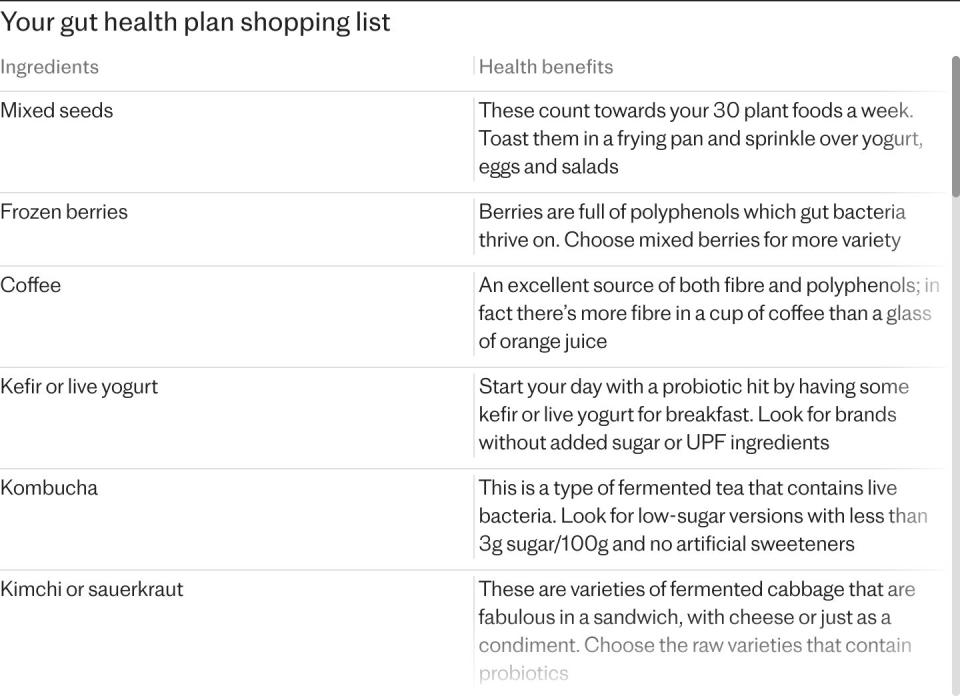

 Yahoo News
Yahoo News 
